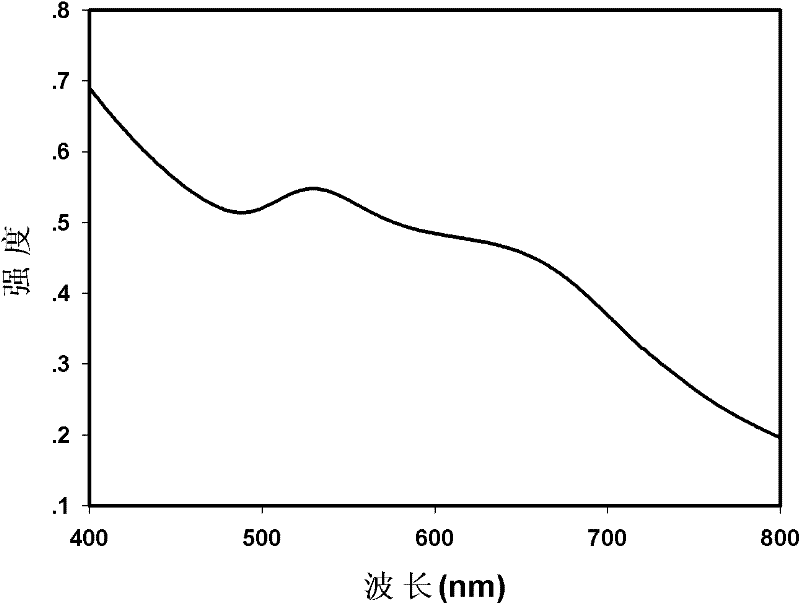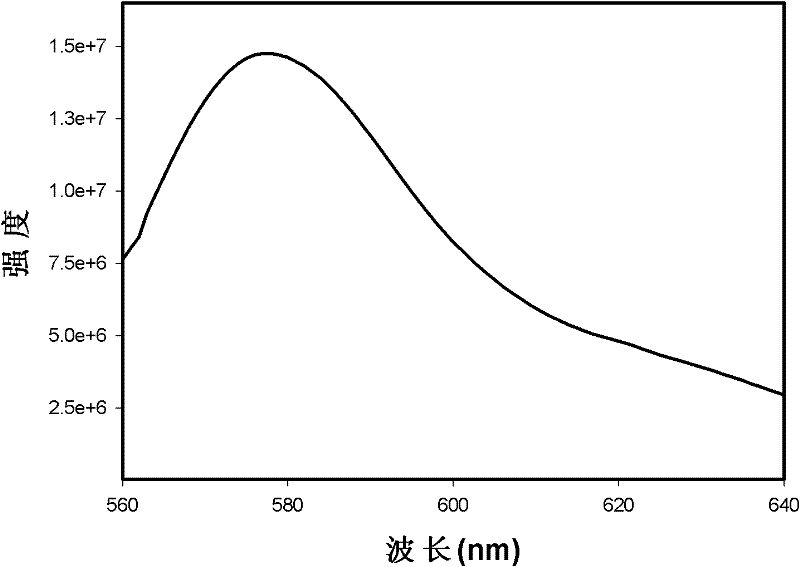Dual-mode optical imaging probe and preparation method thereof
An optical imaging, dual-mode technology, applied in the fields of nanomaterials and bioanalytical chemistry, can solve the problems of further improvement of sensitivity, stability and biocompatibility, complicated preparation methods, etc., and achieve surface-enhanced Raman signals and fluorescence signals. , Good repeatability and high sensitivity
- Summary
- Abstract
- Description
- Claims
- Application Information
AI Technical Summary
Problems solved by technology
Method used
Image
Examples
Embodiment 1
[0023] Examples 1 and 2 use gold nanoparticles as the SERS substrate, 5,5-dithiobis(2-nitrobenzoic acid) DTNB as the Raman marker, and Rhodamine 6G as the fluorescent material for illustration. .
[0024] Example 1
[0025] To prepare a dual-mode optical imaging label using rhodamine 6G as a fluorescent material and DTNB molecules as a Raman marker, the method includes the following steps:
[0026] 1) The experiment uses the method reported by Frens to prepare gold colloidal solution. Under vigorous stirring, 4 mL of citric acid aqueous solution (concentration of 1%) was added into boiling 100 mL of chloroauric acid aqueous solution (concentration of 10 -4 g / mL), continuously stirred and kept boiling for 20 minutes to obtain an aqueous solution of gold nanoparticles, and the average particle diameter of the particles was 15nm. Add 0.2 mL of the aqueous solution of the Raman marker DTNB into 20 mL of the gold nanoparticle solution to a final concentration of 10 -5 ~10 -6 M...
Embodiment 2
[0034] Fluorescence and SERS properties of dual-mode optical imaging probes in living cells (a probe with rhodamine 6G as the fluorescent material and DTNB molecule as the Raman marker)
[0035] 1) Place cervical cancer cells (HeLa) in culture medium for in vitro culture (37°C, 5% CO 2 ). After 24 hours, the aqueous solution of the dual-mode imaging probe was added to the cell culture medium in a volume ratio (3:1), shaken gently, and placed in the incubator again. The probe enters the interior of the cell by being phagocytized by the cell. After 1.5 hours, the medium was aspirated, and the cells were washed 3 times with phosphate buffered saline (PBS) to remove the dual-mode imaging probes that were not phagocytized by the cells and remained in the medium, ready for use.
[0036] 2) Place the cells washed with buffer solution on the stage of a confocal microscope, use 543nm as the excitation wavelength and 560nm-640nm as the receiving wavelength range to obtain the cell flu...
Embodiment 3
[0040] Using silver nano-aggregates as a SERS substrate to prepare a dual-mode optical imaging label using cadmium telluride (CdTe) quantum dots as a fluorescent material and 4-mercaptobenzoic acid molecules (4MBA) as a Raman marker, the method includes the following steps :
[0041] 1) The experiment adopts the method reported by Lee and Meisel to prepare silver colloid solution. will be 1.0×10 -2 M silver nitrate solution was added to deionized water according to the volume ratio of 1:10 to the silver colloid solution to be obtained, stirred and heated to boiling. Add 1% sodium citrate solution into the boiling silver nitrate solution according to the volume ratio of 1:50 to the silver colloid solution to be obtained, keep stirring and heat and boil for 40 minutes to obtain the silver colloid solution. Add 0.2 mL of 4MBA in water to 20 mL of the silver nanoparticles solution to a final concentration of 10 -5 ~10 -6 M, mixing and stirring for 30 minutes, it can be observe...
PUM
 Login to View More
Login to View More Abstract
Description
Claims
Application Information
 Login to View More
Login to View More - R&D
- Intellectual Property
- Life Sciences
- Materials
- Tech Scout
- Unparalleled Data Quality
- Higher Quality Content
- 60% Fewer Hallucinations
Browse by: Latest US Patents, China's latest patents, Technical Efficacy Thesaurus, Application Domain, Technology Topic, Popular Technical Reports.
© 2025 PatSnap. All rights reserved.Legal|Privacy policy|Modern Slavery Act Transparency Statement|Sitemap|About US| Contact US: help@patsnap.com



